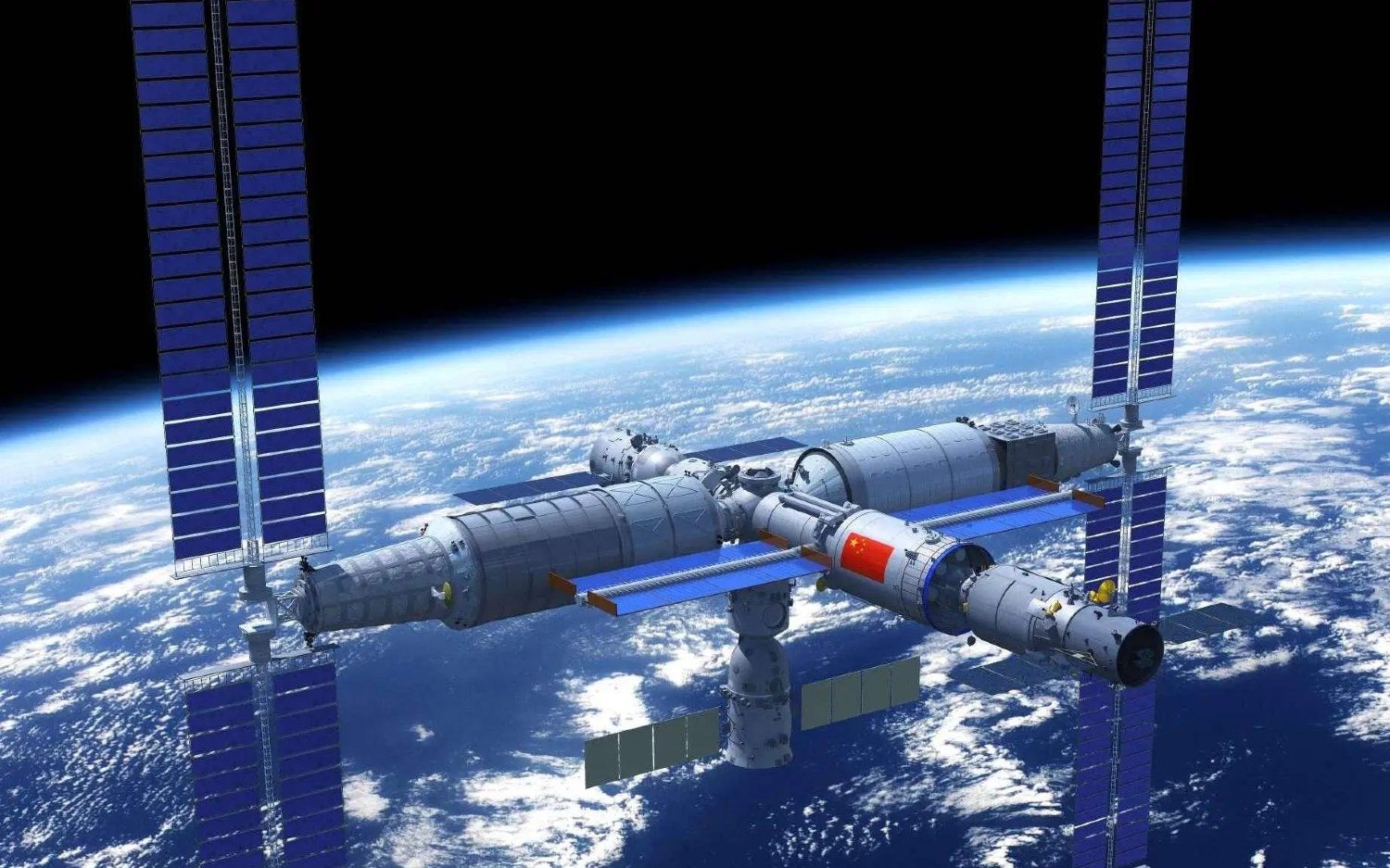China’s recent strides in space technology indicate that the country could even become the world’s biggest and most powerful space power. However, the United States is concerned that these breakthroughs are part of China’s Space Warfare strategy.
In one such breakthrough, China’s space program is one step closer to ensuring more lightweight and efficient energy supplies with the help of a novel power switch and converter device constructed using third-generation semiconductor components.
According to Chinese media, the silicon carbide (SiC) power device, designed by the Chinese Academy of Sciences (CAS), has been tested in orbit since November 2024, when the Tianzhou-8 cargo spacecraft delivered it to the Chinese space station.
“The main task of this mission is to conduct space verification of domestically developed, high-voltage, radiation-resistant SiC power devices and to verify their application in aerospace power supplies,” Liu Xinyu, a researcher at the CAS Institute of Microelectronics (IME), told Chinese state news agency Xinhua on February 2. “We will also research radiation effects, improve the output of China’s aerospace digital power supplies, and support future single modules to reach kilowatt level power,” Liu said.
It is believed that the SiC-based electronics will be essential for upcoming spaceship missions close to the sun, building bases on the Moon and Mars, and other space expeditions. SiC power devices have the potential to cut launch costs, enhance cargo load capabilities, simplify heat dissipation equipment, miniaturize space power systems, and increase power-to-volume ratios by five times.
Building the next generation of aeronautical technology required for China’s space aspirations, including creating a lunar research facility and transporting personnel to the Moon by 2030, will depend heavily on developing more lightweight and efficient power systems. Thus, successful testing could be a breakthrough for the China National Space Administration (CNSA).
This development comes days after astronauts of the Tiangong Space Station successfully conducted experimental extra-terrestrial photosynthesis in orbit ahead of its key space exploration missions.
The China Manned Space Agency (CMSA) said that this innovation will likely serve as a technical basis for the nation’s upcoming manned deep-space exploration missions.
The Tiangong space station is the youngest in the world and has been in service for a little over two years. Its full assembly was completed in November 2022, following the addition of the Mengtian science module. Currently, the space station is getting additional upgrades to expand its capabilities.
BIG SHIFT! U.S. & Russian Navy Warships Drill Together; China, QUAD Nations Also Join Komodo 2025
China is also working on establishing a lunar base in collaboration with Russia. The Moon base is expected to be finished by 2035 and will be situated close to the lunar south pole in the first phase. In the second phase, it will be expanded into a wider network and should be completed by 2050.
Furthermore, China may start its historic attempts to bring samples from Mars to Earth as early as 2028—two years earlier than planned. According to Liu Jizhong, the primary mission designer, the country’s Tianwen-3 mission will launch “around 2028 ” to recover the Martian samples.
Meanwhile, NASA and the European Space Agency’s plan to retrieve Mars samples remains under review amid apprehensions over budget and mission complexity. NASA, which first landed on Mars decades ago, said it is assessing faster and more affordable methods to allow for a speedier result than one that would have returned samples in 2040.
Chinese President Xi Jinping has been vocal about China’s ambitions to become a global space power, indicating that space dominance has become central to China’s military vision.
By 2050, China wants to dominate the space industry. Its all-encompassing strategy includes investigating subjects like quantum mechanics, the origin of the Universe, habitable planets, and extraterrestrial life in addition to the Moon, Mars, and deep space.
However, these breakthroughs and China’s tremendous progress in space have sparked suspicions in the West. Although China stresses that its space ambitions are benign, the United States believes that Beijing wants to militarize space on a large scale.
Interestingly, China developed its space station after being denied access to the ISS because of worries about its space agency’s close ties to the military, particularly the People’s Liberation Army (PLA).

US Worries About Space Militarisation
The West has been suspicious of Chinese intentions since the establishment of the Strategic Support Force (PLASSF) as an independent branch of the PLA in 2015.
This was seen as an impetus to what China calls ‘informatized’ wars of the future. This possibly led the Trump Administration to find a rationale for creating the United States Space Force (USSF) in 2018.
China has ratified every agreement about the peaceful use of space. In 2007, it successfully tested an anti-satellite weapon (ASAT) by blowing up a Chinese weather satellite that had been in use for a long time. China is allegedly developing and testing anti-satellite weapons that could take down adversary satellites in low and high orbits.
China has been testing rendezvous and proximity operations, particularly targeting the GEO (geostationary orbit) belt. In 2022, for instance, a Chinese satellite was seen snatching another long-dead satellite and hurling it a few days later into a 300-kilometer-distant “graveyard” orbit, where spacecraft are less likely to be struck by objects. Such capability can be used to remove or disable an adversary functional satellite during war.
The National Space Intelligence Center of the US Space Force reported in January 2024 that China was developing systems for inspecting and repairing satellites that may be weaponized.
According to the study, the PLA’s GEO satellites with robotic arms represent a threat, especially to “juicy targets,” including US satellites that lack the fuel to maneuver. These threats have only magnified in recent times.
Last year, a US Air Force think tank stated that China’s People’s Liberation Army (PLA) is training its satellite operators for on-orbit satellite refueling, a crucial capability for managing space logistics in both peacetime and wartime scenarios.
More recently, Chinese scientists conducted a simulation operation targeting American billionaire Elon Musk’s Starlink satellite network.
The computer simulation found that just 99 Chinese satellites could successfully approach about 1,400 Starlink satellites in about 12 hours. These satellites could be outfitted with lasers, microwaves, and other tools for tracking, reconnaissance, and other operations.
“The potential military application value of the Starlink mega constellation has been highlighted in the Russia-Ukraine conflict. In recent years, the militarization of space has intensified, posing a significant threat to China’s space security. It is particularly important to track and monitor its operational status,” wrote the project team.
The commander of the United States Space Force, General Chance Saltzman, warned in November 2024 that China’s growing emphasis on militarizing space greatly increases the potential of space war, which is a situation that might seriously jeopardize international security.
“The number of different categories of space weapons that [China has] created and the speed with which they’re doing it is very threatening,” he emphasized.
Saltzman further noted the scope of China’s space capabilities, including the launch of “hundreds of satellites” intended for accurate targeting of assets on Earth, in an interview with Politico. He explained that Beijing’s vast satellite network allows it to carry out operations that go beyond basic surveillance, thereby developing a sophisticated targeting system that may be used as a weapon.
Beijing is also advancing technologies like hypersonic glide vehicles, which can bypass traditional air defense systems and evade satellite-based early-warning systems. This technology, alongside satellite-targeting systems, points to a broader military ambition. In addition to this, some reports suggest that China is developing directed energy weapons for space, with an eye on taking out hostile satellites in case a war breaks out.
Finally, the Pentagon’s annual China Military Power Report, published in December 2024, warned that Beijing’s space advancements suggest it is pursuing global technology and strategic leadership goals in addition to preparing for future space warfare.
- Contact the author at sakshi.tiwari9555 (at) gmail.com
- Follow EurAsian Times on Google News




